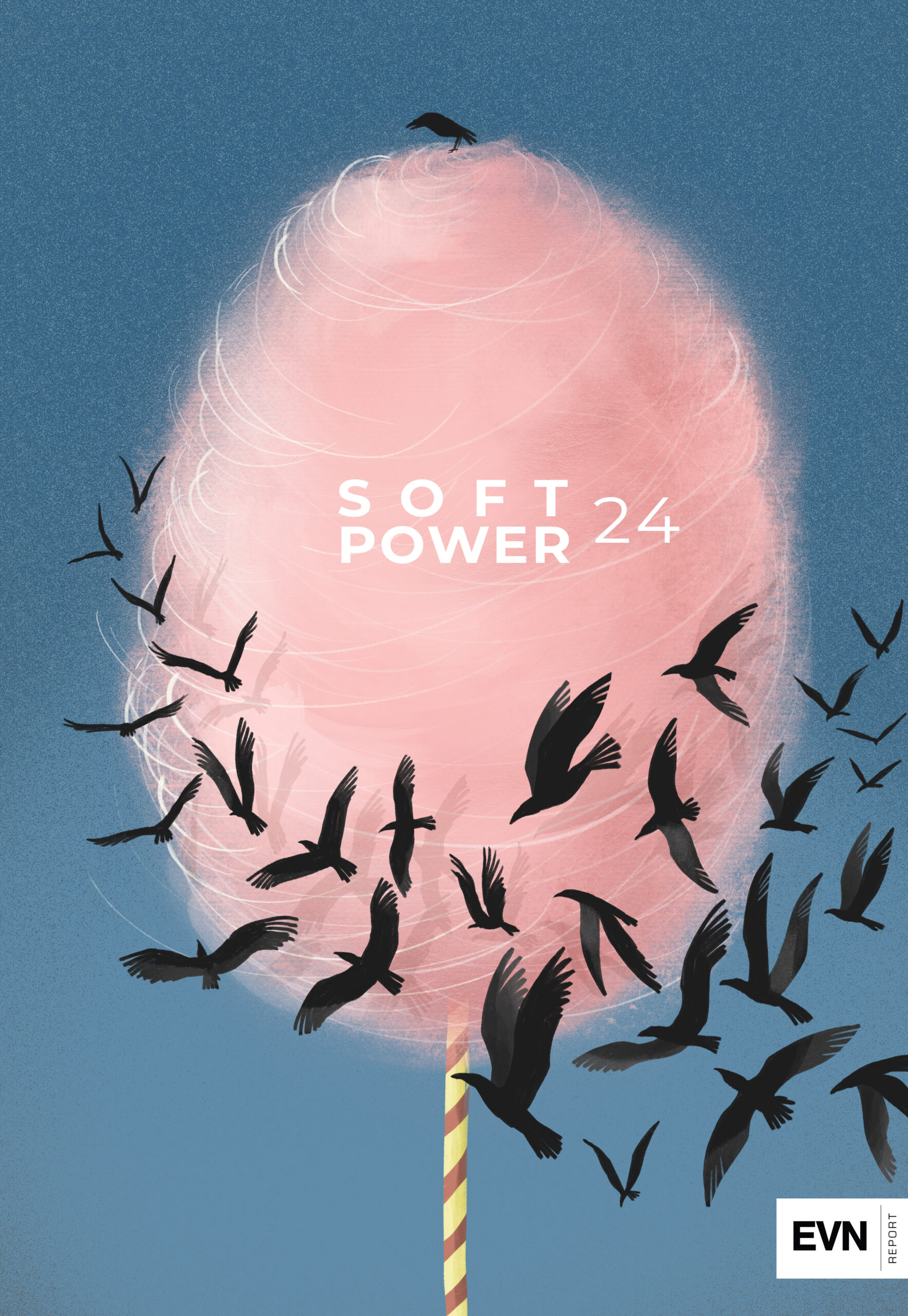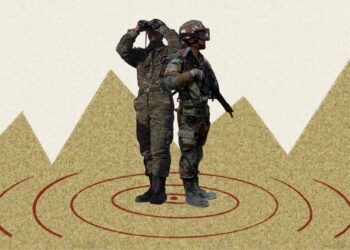
To properly grasp the political realities of reconnecting the South Caucasus and to understand who dominates this process, a return to the fundamentals might be useful.
There is a contradiction between three former empires (Turkey, Russia, Iran) who continue to pursue strategies of domination of their periphery and the three independent states (Armenia, Georgia, Azerbaijan) whose sovereignty remains weak. These states have a much harder time both navigating the international system under pressure from these empires and modernizing their rudimentary institutional apparatuses, which are sources of political and social instability. There is a particularity between nostalgia for empire and the fragile sovereignty of the South Caucasus states, coveted as they are by the three former Empires and the external powers (European Union, United States, China, India).
The final element –– the actors’ strategy –– today depends essentially on the course of the war in Ukraine, a conflict which has become the cornerstone of tomorrow’s world order. If Russia succeeds, it will be the end of independence of all the post-Soviet states which will have to align with Moscow without any room for maneuver. Conversely, in the event of a Russian loss, as is currently looming, Moscow will lose influence on its periphery which could cause instability among direct neighbors (Turkish and Chinese) as well as jihadist threats. The third possible outcome, where there is neither a winner nor a loser, risks a great deal of uncertainty for post-Soviet states which will all have to juggle being good neighbors with Moscow and cooperating with external players. Let’s keep these three war scenarios in mind when taking stock of the actors’ strategies.
The States of the South Caucasus
None of the three states have sanctioned Russia. They welcomed tens of thousands of Russian nationals fleeing combat zones and Putin’s mobilization. In Tbilisi, Yerevan and Baku, these Russian citizens pursue their professional activities and enjoy banking services while supporting the economies of the three states. Moreover, Georgia and Azerbaijan support the territorial integrity of Ukraine in part through old solidarity inherited from GUAM (Georgia, Ukraine, Azerbaijan, Moldova), a regional organization against Russia. As for Armenia, it was suspicious of Ukraine until the military defeat of the 2020 Artsakh War because Kyiv supported Baku militarily, but since Armenia was attacked on its own territory in 2022, Yerevan sees parallels between both the Ukraine and the Armenia-Azerbaijan wars as well as a potential source of rapprochement between the two countries.
Georgia, protecting its sovereignty, does not want to be dependent on the East-West corridor. It now intends to regain its role as a regional hub by playing the North-South corridor card. For this, it is sensitive to the Indian project of a secondary road, maintains better relations with Nikol Pashinyan’s democratic Armenia and offers its mediation in the Armenian-Azerbaijani conflict because Georgia does not want an international conflict on its southern border. Moreover, Tbilisi continues to remain bogged down in negotiations with Russia on the South Ossetia and Abkhazia issues, since the Geneva format has yielded nothing since its establishment in 2008. Georgia is still betting on future membership in the Euro-Atlantic space and spoke out against the “3+3” project (Turkey, Russia, Iran + Armenia, Georgia, Azerbaijan), which rules out any Western presence in regional development. At the same time, Tbilisi is deeply disappointed by the decision to remove its EU candidacy, unlike Ukraine and Moldova. Undoubtedly, Tbilisi is paying the price for not participating in sanctions against Russia and for being governed since 2012 by the Georgian Dream Party, led by the oligarch Bidzina Ivanishvili, who is close to Moscow. If Georgia changes course however, Brussels could reconsider its decision and deem Tbilisi a candidate for the Union again. This is at least the wish of Georgia’s former pro-Western majority, which is trying to mobilize the population against the current regime.
Azerbaijan’s dream is to complement its military victory with a political victory. However, a political victory still does not appear on its agenda. Its hope of a strategic victory that would combine both a military and political victory is being enacting by its peace-by-punishment of Armenia –– namely the suppression of the Karabakh problem, the creation of a “Zangezur Corridor” linking Azerbaijan to its exclave of Nakhichevan and the signing of a peace agreement on the demarcation and delimitation of the border with Armenia and now the almost month-long blockade of the Lachin Corridor by so-called Azerbaijani eco-activists. However, at this time, the Republic of Nagorno-Karabakh, even moribund, is still standing; Russia officially has a contingent of 2,500 soldiers deployed there; and the image of Baku has been considerably tarnished, if not due to years of having welcomed jihadists during its war of reconquest, then at least since September 2022 for having attacked Armenia and occupied part of its territory. Baku multiplied pressure points on Armenia to make it bend and obtain a peace agreement à la Carthage, namely a peace of humiliation and exclusion.
Refusing to participate in sanctions against Moscow, Azerbaijan, on good terms with Russia, Turkey the United States and the European Union, is living a moment of hubris and feels total impunity in pursuing its aims. Baku has become the repository of the Russian-Turkish partnership and fully adheres to the “3+3” project while getting closer to the Collective Security Treaty Organization (CSTO). Baku and Tehran cooperate closely despite mutual mistrust. Baku has signed an agreement with Brussels on the doubling of gas deliveries to Europe in order to diversify supplies to European markets. It can thus count on material assistance from Brussels and Washington to consolidate its economy. Azerbaijan however is in the West’s crosshairs for violating international humanitarian law and committing war crimes, violating the human rights of its own population, and its Armenophobic policies deemed increasingly racist by numerous NGOs and foreign observers.
Armenia, the loser in the 2020 conflict, wants to avoid the worst-case scenario and buy time to avoid any capitulation. Democratically elected but weakened on its territory by the old regime who remained loyal to Moscow, the government of Nikol Pashinyan is betting on economic recovery and the establishment of diplomatic mechanisms to consolidate its position and get out of the Russian-Turkish-Azerbaijani stranglehold. Even if it is not in a position to participate in the sanctions against Russia, let alone the “3+3” project, Yerevan has welcomed American, European, Iranian and Indian initiatives in the region and favored the deployment of a European civilian observation mission along its border with Azerbaijan.
Faced with the CSTO’s refusal to intervene in the aftermath of Azerbaijan’s invasion, Armenia questions the relevance of its membership in this collective security organization. As a result, the Pashinyan government seems to have frozen its activities in this forum while initiating a strategic rapprochement with the United States with the aim not of changing the defense structure but of increasing Armenia’s strategic value. Yerevan has also distanced itself from the irredentism of the former regime and it is also moving away from the resolution of the Karabakh conflict in its initial version (self-determination) –– for which it calls on the international community to ensure the security and the rights of the Armenians of the territory –– and invites the authorities of Stepanakert to consider the option of joining Russia by referendum. Yerevan’s objective above all is to preserve the territorial integrity of the Republic of Armenia, even if this involves the restoration of trade routes between Azerbaijan and Nakhichevan. Armenia rejects talks of a “corridor” and has proposed the opening of three alternative routes under its exclusive control. It also inaugurated a friendship bridge with Tbilisi in the summer of 2022 facilitating North-South trade and welcomed Iranian and Indian multilateral integration projects. Armenia has also accepted the establishment of an Iranian consulate general in the Syunik region’s capital of Kapan, a province coveted by Baku and has signed several contracts with India for the purchase of military equipment.
The Former Empires: Turkey, Russia, Iran
Turkey and Iran do not participate in sanctions against Russia and have long cooperated with Putin in the name of rejecting Western hegemony and a nostalgia for Empire.
Turkey aspires to carry out a policy of balance, on the one hand militarily supporting Baku and Kyiv and on the other hand enacting diplomatic, economic, and military cooperation with Russia and a rejection of any conflict at its gates. In this perspective of appeasement, Turkey has started discussions on normalizing relations with Armenia but conditions the opening of its border with Armenia on the settlement of the conflict with Baku on Azerbaijan’s terms. Ankara is counting on this corridor to buttress its pan-Turkish ambitions and open a land route with Russia, via Azerbaijan, with Armenia relegated to the rank of a reserve state.
Iran is the other big loser in the 2020 Nagorno-Karabakh war. From 1994 to 2020, Armenia’s comfortable position corresponded to the interests of the Moscow-Tehran axis in the face of weakened Azerbaijani nationalism and a Turkey limited in its capacity. Iranian neutrality for nearly three decades amounted to a pro-Armenian position. However, since the defeat of Yerevan in 2020, Tehran faces new complexities: the Iranian regime is wary of Azerbaijani nationalism and has openly opposed any corridor crossing Armenian territory, as Tehran’s border with Armenia is of large strategic, political, economic, cultural and social significance. In this vein, the Iranian regime is increasing military maneuvers in the north of the country, on the border with Azerbaijan, in order to dissuade the Azerbaijanis from settling the dispute with Armenia by force. With regard to Moscow, Tehran is aligned with the Russian army in Ukraine through its sale of kamikaze drones and other military equipment to Russia, hoping to go back to relying on a stronger Armenia to thwart Turkish-Azerbaijani plans. Iran is as suspicious of pan-Turkism as it is of the Western presence in the region or of Israel’s progress in Baku.
Russia is paying for its current difficulties in Ukraine by weakening its positions in the South Caucasus. Its duplicity in the 2020 war and its refusal to intervene alongside Armenia in 2022 through the CSTO reveal fault lines in its alliance with Yerevan, which has translated into a rise of mistrust for Russia in Armenia. Russia’s project of resuscitating its formal imperial glory is floundering. Its intention is to drag Azerbaijan and Armenia into its sling by weakening Armenia for the higher interest of cooperating with Turkey against the West. In the strategic balance, the Russian-Turkish tandem actually weighs more heavily than the old Armenian-Russian alliance. Interested in the creation of a land route linking Russia to Turkey via Azerbaijan and Armenia, Moscow is taking several steps at the same time: Russia is circumventing sanctions by allowing Baku to re-export Russian oil acquired at low prices discreetly towards the West; Russia participates in the tripartite commission with Armenia and Azerbaijan on the demarcation and delimitation of their common borders within the framework of a future peace agreement. Moscow led an information-gathering mission through the CSTO with a view to eventually creating an observation mission on the border between Armenia and Azerbaijan and accused the West of wanting to torpedo the Russian peace plan in the region by offering a Western alternative. Finally, Moscow aspires to open a corridor in Armenia under Russian control in the name of a bilateral alliance. This is due to the fact that Russian military setbacks in Ukraine are forcing the Putin regime to take Yerevan’s interests into account and to stop its policy of weakening Armenia, for fear of seeing the new situation benefit the West.
The Third Circle: Emerging Powers (China, India) and Global Powers (European Union and United States)
China and India also do not participate in the sanctions against Russia and even consider themselves serious partners of the Kremlin, with some nuances, in the South Caucasus. As for the European Union and the United States, subtleties are also hidden in their more robust strategies towards the South Caucasus since the retreat of Russian forces in Ukraine.
China, wanting the creation of new silk roads, maneuvered behind the scenes in favor of a military victory for Azerbaijan in November 2020, vetoing any statement by the UN Security Council calling for an end to the fighting between Armenians and Azerbaijanis as early as October at the request of Russia. It is in the name of defending states’ territorial integrity that Beijing has acted in this way. It also aims to open up new routes far from any Western presence. It is also in the name of this same principle of state sovereignty that China opposes the opening of an extraterritorial corridor in Armenia. In the eyes of Beijing, the opening of trade routes in Armenia under the control of the authorities in Yerevan is sufficient to support Chinese plans. This is especially true as China, guarding its integrity (the Ughyur question) and union (Taiwan) takes a dim view of pan-Turkism and the transformation of the Cooperation Council of Turkic-speaking States (2009) into an Organization of Turkish States in 2021. This organization, nicknamed the Turkish Council, includes Turkey, Azerbaijan, Kazakhstan, Uzbekistan and Kyrgyzstan. Hungary and Turkmenistan are endowed with observer status, and intend to join the pan-Turkish family –– something which greatly worries China.
India, in its quest for greater influence, does not want to depend on anyone and intends to play its own score of strategic autonomy, far from any conflict, but mindful of its national interests vis-à-vis the Chinese and Westerners. Hence the Indian ambition to promote a direct link with the West (QUAD) but also with Russia (INSTC) in an open and peaceful multipolar world. These vast plans for conquering a sphere of influence equidistant from the other poles necessarily cultivate rivalry with Pakistan, the hereditary enemy, and an anchorage in Armenia, a partner all the more privileged since Pakistan supports Azerbaijan in the Caucasus. For these reasons, New Delhi is stepping up all-out approaches towards Yerevan. It does so in the diplomatic field by denouncing Azerbaijan’s aggression against Armenia at the UN Security Council and rejecting the idea of a extraterritorial corridor in Armenia as well as in the field of security, with the sale of arms to Yerevan in 2021-2022 (radars, Pinaka multiple rocket launcher trucks and anti-tank missiles).
The European Union is keen to consolidate regional peace and reactivate its Eastern Partnership since the effects of the Russo-Georgian war (2009), the Donbas crisis (2013), Russia’s annexation of Crimea (2014), the Armenian-Azerbaijani wars (2016 and 2020) and the war in Ukraine since 2022. In the eyes of Europeans, all the crises in Eastern Europe are interconnected and developments in one conflict necessarily have effects on others. The European Union wishes to strike a balance in the South Caucasus by announcing a substantial aid package of 2.5 billion Euro over five years to Armenia through major structural reforms and a fiercer fight against corruption. With regard to Azerbaijan, Brussels has signed a gas agreement to diversify its hydrocarbon supplies and end its energy dependence on Russia. More concretely, the European Union offered its mediation in the Armenia-Azerbaijan conflict by multiplying the tripartite meetings in Brussels, which resulted in the deployment of a European civilian mission in Armenia in autumn 2022 for a two-month duration, which Armenia would like to expand. Brussels thus intends to restore the economies of the three South Caucasian states, declares itself in favor of opening new roads, finances infrastructure projects between Tbilisi and Yerevan and opposes any extraterritorial corridor in Armenia. The European Union also wants to defend the territorial integrity of the three sovereign states and demotes the Karabakh issue to its diplomatic agenda.
The United States fully understands that its South Caucasian strategy will always be weak as long as Moscow-Yerevan relations are in good shape. Since the 2020 Artsakh War and Azerbaijan’s 2022 invasion of Armenia, Washington has jumped at the opening space for engagement by “opening a breach” in Armenia’s security policy and by multiplying steps in Yerevan’s favor. In 2021, President Biden recognized the Armenian Genocide, thereby projecting its soft power in the region to the chagrin of Russia, Turkey and Azerbaijan. In the summer of 2022, as Russia retreated in Ukraine, the United States dispatched CIA director William Burns to Armenia. Then Philipp Reeker, veteran American ambassador, went to Armenia on behalf of his new diplomatic responsibilities as special negotiator of the United States in the South Caucasus. Finally, Nancy Pelosi, President Joe Biden, his Secretary of State, Anthony Blinken and the Under-Secretary of Defense, Colin Kahl are taking steps to support Armenia, including in the military sphere.
At the same time, Washington has been clear with Yerevan: it is not up to the United States to directly provide military aid to Armenia, it is up to the Armenian government to declare its needs. The Biden administration took steps to obtain a ceasefire on September 14, 2022 during the Azerbaijani aggression and facilitated a trilateral meeting on the sidelines of the United Nations General Assembly in September 2022. Washington condemned the 2022 Azerbaijani aggression and called on Baku to return to its original positions as well as to release all Armenian prisoners detained since November 2020. The US Congress is also examining the possibility of sanctioning Baku for war crimes and aggression against Armenia. What about the question of the status of Nagorno-Karabakh, barely addressed in official American statements? Washington, like Paris, seems to favor the issue of respect for Armenia’s sovereignty –– with total rejection of any extraterritorial corridor –– to the detriment of the Karabakh issue, which has been postponed indefinitely.
More than ever, the key to peace in the South Caucasus depends on the course of the war in Ukraine and the question of the future of Armenia, Azerbaijan and Georgia can be boiled down to three essential dynamics. The first dynamic is that of geopolitical and geoeconomic questions: will the domination of the South Caucasus generate a thrust of the post-Western world symbolized by the neo-imperial powers in a position of quasi-monopoly with their nuances and divergences between them? On the contrary, will it play the game of the defenders of the current world order embodied by Western powers? Or will no power succeed in dominating this strategic space, which has become pessimistically a perpetually unstable gray zone on the fringes of international life, or optimistically an open and globalized market?
The second dynamic is strategic and diplomatic: the setting up of two observation missions in Armenia, –– an EU mission supported by Washington and the CSTO mission supported by Russia. Could this be a sign of a strategic confrontation to come between rival organizations deployed on the ground or an experiment of a double diplomatic mechanism that could serve as a reference in negotiations to come in Ukraine?
Finally, the third dynamic is one of peace and influence: which peace scenario will prevail in the resolution of the conflict between Armenia and Azerbaijan? The Russian approach or the Western approach? The Russian approach to peace consists of keeping the question of Karabakh on the agenda in its hazardous status quo and on the other hand in controlling a proposed corridor crossing Armenia in order to preserve Russian influence in the region while ensuring a minimum of guarantees for Azerbaijan, Armenia and Turkey? The Western approach to peace respects the territorial integrity of the three states, with the indefinite postponement of the Karabakh issue within Azerbaijan but also involves the categorical refusal of an extraterritorial corridor in Armenia. .
All these processes simultaneously take place and there is no indication at this time which of them is more likely to be realized, including the worst-case scenario of a new war of Azerbaijani aggression in Armenia. The South Caucasus thus remains in its crossroads status, this time with a dilemma: peace of inclusion or peace of punishment? Pax russica or pax occidentis?
Also see
How the War in Ukraine Intersects With the South Caucasus, Part I
The interplay between two conflicts, one in Eastern Europe, the other in the Caucasus provides a global dimension to the issues they contain. Beyond the common space-time matrix, what can we learn from what lies at the nexus of these two conflicts?
Read moreEVN Security Report: December, 2022
Ontological Security and Azerbaijan’s Aversion to Peace
EVN Security Report: December 2022
The security context in December showed that regardless of negotiations or the general contours of a potential peace treaty, actual and sustainable peace with the Aliyev Government will remain elusive. This month’s security report introduces the concept of ontological security.
Read moreMagazine Issue N25
Reflection
Magazine Issue N24
Soft Power
Magazine Issue N23
N.E.W.S.
















